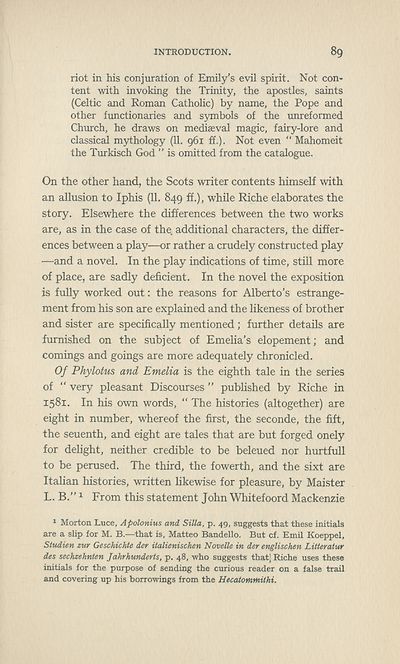Download files
Complete book:
Individual page:
Thumbnail gallery: Grid view | List view

INTRODUCTION.
89
riot in his conjuration of Emily's evil spirit. Not con¬
tent with invoking the Trinity, the apostles, saints
(Celtic and Roman Catholic) by name, the Pope and
other functionaries and symbols of the unreformed
Church, he draws on mediaeval magic, fairy-lore and
classical mythology (11. 961 ff.). Not even “ Mahomeit
the Turkisch God ” is omitted from the catalogue.
On the other hand, the Scots writer contents himself with
an allusion to Iphis (11. 849 ff.), while Riche elaborates the
story. Elsewhere the differences between the two works
are, as in the case of the additional characters, the differ¬
ences between a play—or rather a crudely constructed play
—and a novel. In the play indications of time, still more
of place, are sadly deficient. In the novel the exposition
is fully worked out: the reasons for Alberto’s estrange¬
ment from his son are explained and the likeness of brother
and sister are specifically mentioned ; further details are
furnished on the subject of Emelia’s elopement; and
comings and goings are more adequately chronicled.
Of Phylotus and Emelia is the eighth tale in the series
of “ very pleasant Discourses ” published by Riche in
1581. In his own words, “ The histories (altogether) are
eight in number, whereof the first, the seconde, the fift,
the seuenth, and eight are tales that are but forged onely
for delight, neither credible to be beleued nor hurtfull
to be perused. The third, the fowerth, and the sixt are
Italian histories, written likewise for pleasure, by Maister
L. B.” 1 From this statement John Whitefoord Mackenzie
1 Morton Luce, Apolonius and Silla, p. 49, suggests that these initials
are a slip for M. B.—that is, Matteo Bandello. But cf. Emil Koeppel,
Studien zur Geschichte der italienischen Novelle in der englischen Litteratur
des sechzehnten Jahrhunderts, p. 48, who suggests that] Riche uses these
initials for the purpose of sending the curious reader on a false trail
and covering up his borrowings from the Hecatommithi.
89
riot in his conjuration of Emily's evil spirit. Not con¬
tent with invoking the Trinity, the apostles, saints
(Celtic and Roman Catholic) by name, the Pope and
other functionaries and symbols of the unreformed
Church, he draws on mediaeval magic, fairy-lore and
classical mythology (11. 961 ff.). Not even “ Mahomeit
the Turkisch God ” is omitted from the catalogue.
On the other hand, the Scots writer contents himself with
an allusion to Iphis (11. 849 ff.), while Riche elaborates the
story. Elsewhere the differences between the two works
are, as in the case of the additional characters, the differ¬
ences between a play—or rather a crudely constructed play
—and a novel. In the play indications of time, still more
of place, are sadly deficient. In the novel the exposition
is fully worked out: the reasons for Alberto’s estrange¬
ment from his son are explained and the likeness of brother
and sister are specifically mentioned ; further details are
furnished on the subject of Emelia’s elopement; and
comings and goings are more adequately chronicled.
Of Phylotus and Emelia is the eighth tale in the series
of “ very pleasant Discourses ” published by Riche in
1581. In his own words, “ The histories (altogether) are
eight in number, whereof the first, the seconde, the fift,
the seuenth, and eight are tales that are but forged onely
for delight, neither credible to be beleued nor hurtfull
to be perused. The third, the fowerth, and the sixt are
Italian histories, written likewise for pleasure, by Maister
L. B.” 1 From this statement John Whitefoord Mackenzie
1 Morton Luce, Apolonius and Silla, p. 49, suggests that these initials
are a slip for M. B.—that is, Matteo Bandello. But cf. Emil Koeppel,
Studien zur Geschichte der italienischen Novelle in der englischen Litteratur
des sechzehnten Jahrhunderts, p. 48, who suggests that] Riche uses these
initials for the purpose of sending the curious reader on a false trail
and covering up his borrowings from the Hecatommithi.
Set display mode to: Large image | Zoom image | Transcription
Images and transcriptions on this page, including medium image downloads, may be used under the Creative Commons Attribution 4.0 International Licence unless otherwise stated. ![]()
| Publications by Scottish clubs > Scottish Text Society publications > Third series > Miscellany volume > (105) |
|---|
| Permanent URL | https://digital.nls.uk/106932817 |
|---|
| Description | A collection of over 100 Scottish texts dating from around 1400 to 1700. Most titles are in Scots, and include editions of poetry, drama, and prose by major Scottish writers such as John Barbour, William Dunbar, Gavin Douglas, and George Buchanan. Edited by a key scholarly publisher of Scotland's literary history, and published from the late 19th century onwards by the Scottish Text Society. Available here are STS series 1-3. |
|---|

